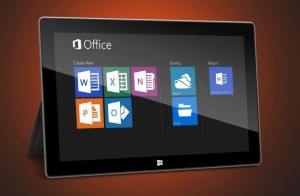 Although consumers and businesses are turning more often to Web-based software and mobile apps, many millions still depend on Microsoft Office to get their work done every day. The folks in Redmond want you to use Office wherever you go—on your PC, your tablet, and your Windows Phone handset. To that end, Microsoft is pushing deep integration between its desktop applications and your data, stored on Microsoft servers.
Although consumers and businesses are turning more often to Web-based software and mobile apps, many millions still depend on Microsoft Office to get their work done every day. The folks in Redmond want you to use Office wherever you go—on your PC, your tablet, and your Windows Phone handset. To that end, Microsoft is pushing deep integration between its desktop applications and your data, stored on Microsoft servers.
Office 2013, the next edition of Microsoft’s flagship productivity suite, is available for business customersbut won’t go on sale to consumers until the first quarter of 2013. This review focuses on the desktop applications, which you’ll be able to buy either on their own or as part of the cloud-connected Office 365 suite next year. We’ll review Office 365 when it becomes available.
Both the Office 2013 and Office 365 packages provide online document storage and collaboration. The primary difference between the two? Office 365 is constantly updated, and it lets you run Office away from your main PC via an Office on Demand virtualisation tool. Office 365 users get extra online storage and, for the Small Business option, add-ons such as shared calendars and HD video conferencing.
In addition to the highly touted cloud features, the new Office desktop applications look sleeker and deliver several useful improvements.
Pricing
Unfortunately, the suite also costs more. The $140 Office 2013 Home and Student version includes Word, Excel, PowerPoint, and OneNote. The $220 Home & Business edition adds Outlook, and the $400 Office 2013 Professional package throws in Publisher and Access. Not only are those prices a bit higher than for comparable versions of Office 2010, but they also cover just one installation; Home and Student 2010 allowed three, and previously Microsoft discounted multiple-license purchases of other editions.
If you need Office on only a single PC, an Office 365 subscription quickly costs more after a year or so. On the other hand, if you use Office on multiple PCs, you’ll find that Office 365 subscriptions—which include five Office 2013 installations and start at $100 a year—are cheaper over several years. The $150 Office 365 Small Business Premium looks like the best deal for small companies. You’ll have to do the math for your situation.
Redesign
Microsoft’s Office redesign uses white backgrounds pretty much everywhere, and the net effect is less clutter. A more subtle innovation is the use of animation that can make normal transitions look more fluid (you can disable these effects if you wish). And Microsoft has made several routine operations easier to perform from within the apps.
Word, Excel, and PowerPoint no longer show a blank page at launch. Instead, a landing screen presents templates and other options for creating or reopening a document—that’s basically the screen you used to get when you wanted to open an existing document or create a new one from a template. This screen exposes ready-made design options that you might not otherwise consider.
The suite also offers easy integration with Microsoft’s online storage options, through the free SkyDrive or, in corporate settings, via commercial SharePoint server accounts. This arrangement makes documents available wherever you may need them. Microsoft has also worked on making Office more tablet- and touchscreen-friendly.
Word for reading, not just writing
One of Word’s most visible innovations is a new Read Mode that dispenses with the ribbon toolbar and lets you see documents as though they appeared within a printed book. In this mode, you can’t edit, but you do have access to find and search tools, so you can perform lookups related to highlighted content. Another new mode provides a navigation pane, useful for getting around in lengthy documents.
In Read Mode, you can click graphical elements to enlarge them for closer study (Microsoft calls thisobject zoom), and then click them again to return to the original layout.
Word also automatically bookmarks the page you were last on when you closed a document, and lets you return to that page when you reopen it. That bookmark travels with the document, which means that if you save the document to SkyDrive, your other Office 2013 installations will also open on the bookmarked page—useful when you’re working with lengthy documents.
If you’re using a connected PC or device, you can watch video embedded in a Word document without even leaving Word.
You can also search popular photo-sharing sites for images and add the ones you like to your documents from within Word—no need to save them to your computer first. The same goes for screenshots: The new Insert Screenshot command brings up thumbnails of all currently running apps on your computer, and then inserts the one you choose (after which you can crop it). When you insert an image or other object, Word can reflow the text on the fly so that you immediately see what you’re getting.
The new Design tab gathers styles and other formatting options in one place, so you can easily try out different looks for your work. Word also now supports PDF editing (it converts PDFs to Word and then saves them back as PDFs). In my tests, regrettably, Word mangled the formatting somewhat on a complex PDF, but it fared better with simpler forms.
Next page: More about Word, plus Excel
Word offers a few innovative sharing options beyond SkyDrive. For instance, you can show your Word document to someone who isn’t running Word by creating and sending a share link (available either with or without editing privileges). This lets the recipient see (and, if authorised, edit) the document in a browser as you scroll through it. The program also has a command for posting to social networks, which basically provides a read-only or read-write link to the document in SkyDrive.
Microsoft has also tweaked the review and revision tools. The cleaned-up Simple Markup view spares you a lot of the clutter from deletions and comments in a heavily edited document. Word now supports replies to comments for more orderly tracking of conversations, and once a comment has been addressed, you can mark it as done. You can also password-protect the ability to stop tracking changes, so no one can fiddle with a document without being detected.
Excel adds tools for analysing data
Excel 2013 has some of the most appealing and potentially useful new features in the Office 2013 suite, as the additions help with entering, analysing, and presenting spreadsheet data.
The new Flash Fill feature can detect patterns (beyond the numerical and date patterns Excel has long been able to recognise), and auto completes empty fields as appropriate.
For example, if you’ve pasted a list of similarly formatted email addresses (say, firstname.lastname@domain.com) into a column, you can then type the first two first names into the first two cells of another column, select the entire column, and click the Flash Fill option to see Excel insert the rest of the first names instantly.
Excel also makes it easier to figure out how to wrangle a bunch of data in a spreadsheet. Select an entire table, and a small Quick Analysis button appears by the lower-right corner. You can click the button to view thumbnails of several graph and charting options, and then click one to apply it. Not sure how best to massage the data? Excel also offers buttons that generate chart and pivot table recommendations. A timeline slicer makes it easier to examine data from a specific time period within a larger set of data. Creating mashups with third-party data sources is also easier.
A more mundane but welcome change involves keeping multiple spreadsheets open. In Office 2013, each workbook gets its own window, which makes viewing two or more at once a lot easier. As with Word, you can share your spreadsheets with non-Office users by sending a link (so the recipients can either just view the document or both see and write to it in a browser), or by posting to a social network.
PowerPoint: Design, collaboration, sharing tools
Many of the innovations in PowerPoint 2013 mirror those in Word, including a reading view, the capability to add screenshots and art from photo-sharing sites from within the application, object zoom, instant visibility for formatting changes, enhanced commenting features, and the Design tab.
PowerPoint 2013 makes adjusting design elements simpler by showing options in a new formatting pane to the right of the slide. You summon the pane in the menu that appears when you right-click a selected object such as an image, shape, or text.
Next page: More about PowerPoint, plus Outlook and more
PowerPoint’s enhanced media support includes the ability to play more video formats and the option of having background audio play across your entire presentation.
For presenters with two screens at their disposal (one for the audience and one for themselves), the Presenter View makes it easier than ever to access notes and preview upcoming slides. If the Presenter View somehow winds up on the wrong screen, the Swap Display command quickly deals with the problem.
Coauthors can collaborate on a presentation using the PowerPoint Web app. And for those people who skipped Office 2010, the ability to broadcast a presentation online by sending a link to audience members bears mentioning as a very cool feature.
A cleaner Outlook
Last time around Outlook got a ribbon, but it also grew cluttered. Microsoft has addressed this issue in Outlook 2013, which opens with a simple two-pane design consisting of the list of messages and the selected message in the preview pane. You can quickly respond to the message by clicking the Reply button in the preview pane.
If you want more than two panes open, Outlook 2013 will oblige. You can choose between several layouts in the View tab, including ones with panes for your calendar, your to-do list, or the People (formerly Contacts) pane, where you can also see updates from social networks you’ve set up using Outlook Social Connector (introduced in Office 2012).
At the bottom of the screen, you can click either Calendar, People, or Tasks to switch views, or hover to get a peek—via a small pop-up—at your selection. This Peeks feature allows you to access information without having to change views completely.
A new feature called Mailtips will bring possible issues to your attention, such as if you fail to forward an attachment. In corporate environments where IT pros set policies for email, Outlook will point out potential violations.
One curious innovation: The Calendar view now includes a couple of days’ worth of weather information.
OneNote, Publisher, and more
Microsoft has endowed other Office apps with design improvements similar to those in the big core programs, including the capability to suppress all or part of the ribbon, and the landing page at launch. OneNote, for example, benefits from the easy screenshot capture in Word and PowerPoint; it also sports improved tools for modifying tables, and it can update embedded Excel and Visio files when their content changes. As with other Office apps, you can share a OneNote notebook stored online by sending a link for viewing and, if you allow it, editing the content from a browser.
Publisher 2013 offers the same design, formatting, and design tools as Word and PowerPoint do. It now lets you collect images on the area next to a document, and then try them one at a time by using a Swap Image button.
Visio 2013, Microsoft’s business-diagramming app, gets new styles and templates. It also supports collaboration features, but only for SharePoint users or Office 365 subscribers—there’s no free SkyDrive support, which makes sense for such a hard-core business program. A new wizard helps you link graphical elements in your diagrams to data sources, so if the data changes, the diagram does too. Sources supported include Excel, SQL server, and SharePoint External Lists.
Microsoft offers two versions of Project 2013 with standard perpetual licenses: Project Professional and Project Standard. But the push with Office 2013 is clearly for the Office 365 version, or at least a version that can be hosted within a business.
Bottom line
Is Office 2013 a must-have upgrade? Not necessarily for Office 2010 users. But people whose interactions with Office occur primarily on desktop computers within the big four core apps—Word, Excel, PowerPoint, and Outlook—will generally find more formatting options than ever, plus some new view modes, including options for collapsing or even hiding the ubiquitous ribbon introduced in Office 2007. (In collapsed view you see only the tab headings.)
Overall I’m happy with the changes introduced in Office 2013. They refine a lot of the features in Office 2010, and if investing in the subscription-based Office 365 license makes sense financially for you, the upgrade is a no-brainer.
But for people who work on a single desktop, or who are happy using third-party cloud services such as Dropbox or Google Drive, upgrading—especially from Office 2010—will probably be less appealing, given the expense. Microsoft has done good work, but this year’s suite is not necessarily an essential upgrade.





